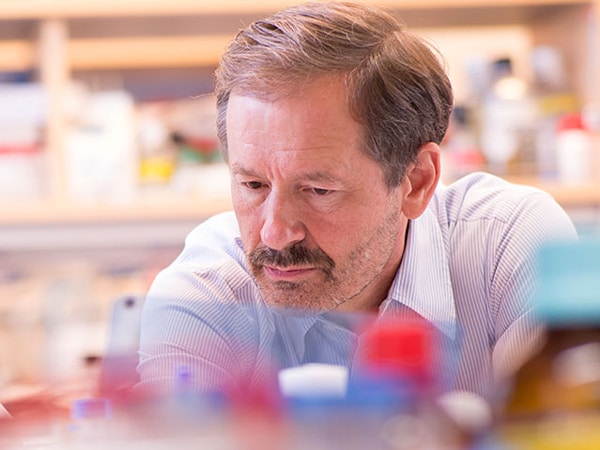Propelling Progress in Pancreatic Cancer Research
A career development grant from the AACR initiated the development of a model to help understand one of the deadliest and most difficult-to-treat types of cancer.
David A. Tuveson, MD, PhD, is a renowned physician-scientist whose trailblazing research is widely recognized for advancing preclinical and clinical work on therapeutic strategies for patients with pancreatic cancer.
Today, Dr. Tuveson is president of the American Association for Cancer Research (AACR); the chief scientist of the Lustgarten Foundation for Pancreatic Cancer Research; director of the Cold Spring Harbor Laboratory Cancer Center; and an elected Fellow of the AACR Academy.
But in 1997, as a new postdoctoral fellow in the laboratory of Tyler Jacks, PhD, FAACR, at Massachusetts Institute of Technology (MIT), he was an early-career physician-scientist whose experiences with patients with pancreatic cancer as a medical resident at Brigham and Women’s Hospital in Boston piqued his interest in the difficult-to-treat disease.
He recognized that researchers needed a better way to study pancreatic cancer, one of the deadliest types of cancer, and develop effective therapeutic approaches to help patients. At the time, Dr. Jacks’ lab was conducting research on genetically engineered mouse models to help study cancer.
“The lab was very supportive of a variety of approaches,” Dr. Tuveson explained. “The approach we took was to change the genes in a mouse so that they reflected the genetic mutations found in a pancreas cancer tumor.”
“It’s easy to say that, but it takes some time to do that, to actually generate an animal that has exactly those mutations in it,” he added.
In fact, perfecting a mouse model for pancreatic cancer took Dr. Tuveson years of work at four different institutions—MIT, the University of Pennsylvania, the Cambridge Research Institute, and Cold Spring Harbor Laboratory.
As a postdoc, however, Dr. Tuveson could see a “glimmer” of evidence that he had the right approach. He used the preliminary data to apply for, and win, a grant from the AACR—the AACR-PanCAN Career Development Award.
“It was an impactful award, in that it introduced me to a field of researchers that I didn’t know, in the field I had just entered,” he said. “I would say any dollar you get from an AACR grant is 10 to a hundred times more impactful for that person because of the doors it opens.”
That initial grant—his first as a researcher—enabled him to advance his research and helped him successfully secure a larger, longer-term grant from the National Cancer Institute (NCI).
“It was off to the races after that,” he said. “I had enough resources to really do anything I was thinking of.”
He cited the AACR-PanCAN grant, among others, in a landmark 2005 study in the scientific journal Cancer Cell, in which he discussed the mouse model, called KPC. In the article, Dr. Tuveson explained that “K” stands for KRAS and “P” stands for TP53, genes that are frequently mutated in many tumor types, including pancreatic cancer. The KPC mouse contains mutations in both of these genes, which leads to a tumor-promoting synergy. The “C” stands for Cre, the genetic tool that ensures that only the genes in pancreas are mutated, so tumors don’t form in other parts of the mouse.
The mice develop the precursor lesions known as pancreatic intraepithelial neoplasia and go on to develop full-blown cancer that closely mimics human pancreatic cancer. On microscopic examination, the mouse tumors look like human tumors. In the 2005 study, Tuveson noted that the KPC mice lost weight and muscle mass and experienced build-up of fluids in the abdomen and yellowing of the skin, similar symptoms to human patients with pancreatic cancer.
The mouse model has been highly validated and, to this day, remains clinically relevant for pancreatic cancer investigators around the world.
“Because we created this animal model, we could then ask really fundamental questions about pancreatic cancer, such as, why is it so hard to treat patients?” remarked Dr. Tuveson. “And we discovered that drugs don’t get delivered to the tumor very well because the blood vessels in a pancreas tumor are smashed shut. They are compressed.”
This observation stimulated Dr. Tuveson’s laboratory and many others to investigate better ways to deliver therapeutics into the tumor. But after more than 20 years of work in the field, Dr. Tuveson is frank in admitting that pancreatic cancer is still a fearsome disease.
“We’re not where we need to be,” he said. “We need much more research in the clinic that goes back to the laboratory so that the doctors and the scientists can tag-team. I think that whatever we figure out in pancreas cancer, I suspect will help other cancer types as well.”
Now, nearly 25 years after beginning his work on the KPC mouse model, Dr. Tuveson said the progress that has been made underscores the importance of the AACR’s grant giving in driving progress against the collection of diseases called cancer.
“The AACR grants program is a growing part of our portfolio to support cancer research, to attract new people to the field, and to enable collaborations across institutes or even across countries,” he said. “We are taking it as a priority to encourage the development of this next generation of cancer scientists and cancer doctors.”
With catalytic grants and awards funded by donors and in collaboration with other organizations, the AACR is nurturing high-impact cancer science across the continuum of cancer research and care, including career development awards to encourage the best and brightest young minds in the field.
“It’s something we should cherish and do whatever it takes to promote,” Dr. Tuveson said.
Return to AACR Stories Home
